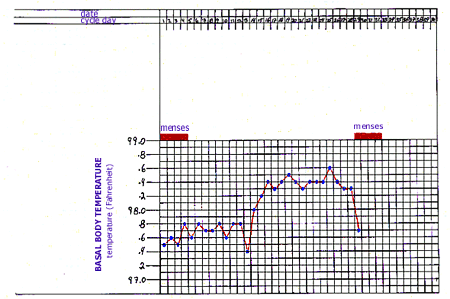| visit: www.infertilitytutorials.com |
|
Basal Body Temperature
Basal body temperature charting has been used to detect ovulation for ages. This is a simple and inexpensive way of gathering information about ovulation. Unfortunately, it takes about 1-2 months to collect an adequate amount of data for interpretation and the data that is collected is sometimes uninterpretable. The underlying principle of basal body temperatures is that a woman's temperature is slightly lower during the initial phase of the menstrual cycle (when she is maturing an egg for ovulation) than it is during the latter phase of the cycle (after ovulation but prior to the next menses). The temperature during the second part of the cycle is usually about 0.4° F to 0.6° F higher than during the first part of the cycle, and most often the basal temperature shifts from less than 98° F (prior to ovulation) to greater than 98° F (following ovulation). A "metabolic" thermometer (which is designed to be easy to read for temperatures around 97-99° F) should be purchased. I always suggest a mercury thermometer since they seem to be more accurate. I have not had a good experience with the digital thermometers for basal temperature charting. The temperature is taken every morning prior to getting up, brushing teeth, or drinking any fluid. The thermometer should be kept in the mouth under the tongue for a full 5 minutes (by the clock) and the temperature recorded on the chart. There is normally a daily (small) fluctuation in temperature throughout the cycle. A detectable increase in the overall temperatures that lasts for about two weeks just prior to a vaginal flow suggests that ovulation is occurring. | |||||||||||||||

